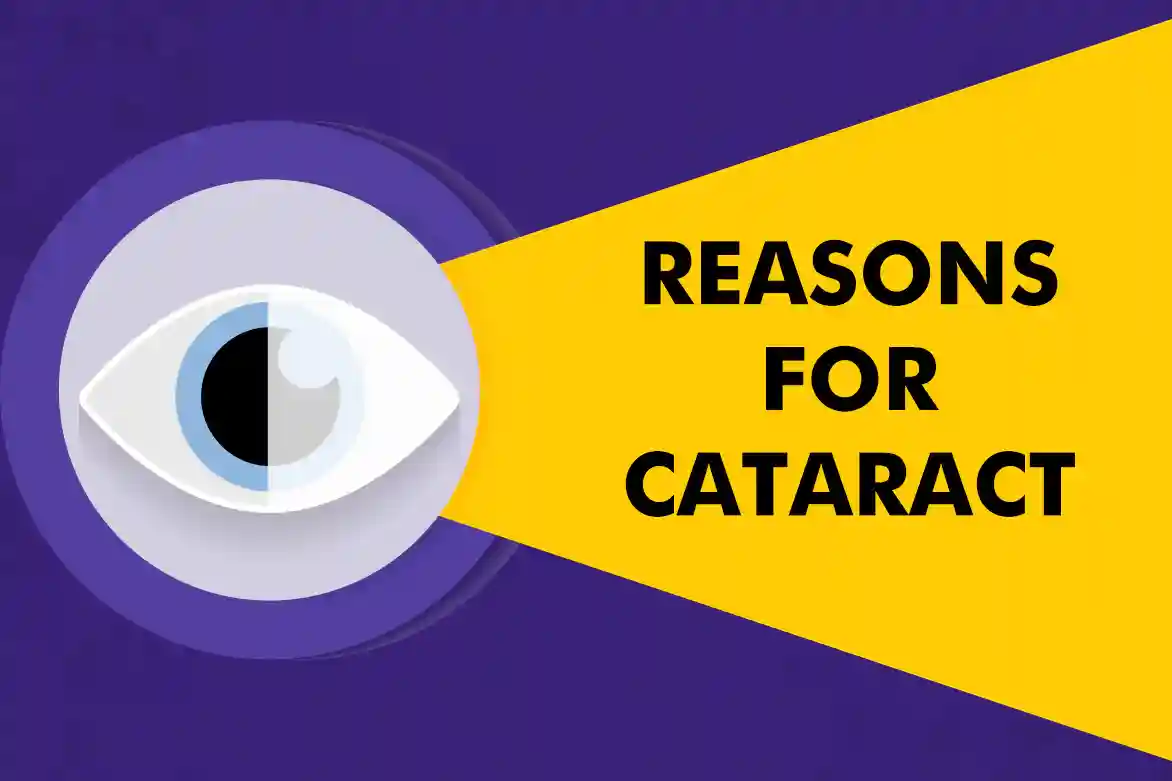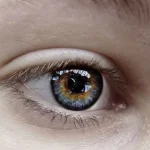Key Takeaways:
|
Cataracts can be caused by ageing, excessive sun/UV exposure, smoking, diabetes or high blood sugar, long-term steroid use, eye injury or previous eye surgery, family history, radiation exposure, heavy alcohol consumption, and poor diet.
Some risk factors you can’t change (age, family history), while others you can manage (UV exposure, smoking, diabetes, long-term steroid use). In this blog, you’ll learn the main reasons for cataracts, how cataracts are formed, and how to avoid cataracts.
What Are Cataracts?
A cataract is an eye condition in which the eye’s clear lens becomes cloudy, making vision blurry or hazy. This happens as lens proteins change and clump with age, scattering light. Cataracts are common and treatable with surgery when vision starts to affect daily life.
Main Causes of Cataracts
If you’re wondering what causes cataracts, most cases are related to ageing; however, other risk factors, such as UV light, smoking, diabetes, steroid medications, eye injuries, poor nutrition, and exposure to radiation/air pollutants, also play a role.
Below is a detailed list summarising the main causes of cataracts, how they develop, key statistics, and simple prevention tips.
Ageing
- How it leads to cataract: Lens proteins aggregate, causing the lens to become cloudy over time.
- Statistics: Age-related protein changes/aggregation drive opacity.
- Simple prevention: Routine eye checks after 40; manage other risks.
UV Radiation (Sunlight)
- How it leads to cataract: UV damages lens proteins and fibers (oxidative stress).
- Statistics: ~10% of cataracts worldwide may be due to excessive UV (avoidable) exposure.
- Simple prevention: Wear UV400 sunglasses + hat outdoors.
Smoking
- How it leads to cataract: It increases oxidative stress in the lens.
- Statistics: Smokers are 2–3× more likely to develop cataracts.
- Simple prevention: Quit smoking; get help if needed.
Diabetes
- How it leads to cataracts: High sugar levels can alter the lens and speed up cataracts.
- Statistics: People with diabetes are ≈2× more likely to develop cataracts earlier.
- Simple prevention: Keep HbA1c within target; have regular eye exams.
Steroid Medicines
- How it leads to cataract: It can cause posterior subcapsular cataract (PSC).
- Statistics: Prolonged glucocorticoid use increases PSC risk.
- Simple prevention: Use the lowest effective dose; review with your doctor.
Eye Injury (Trauma)
- How it leads to cataract: A blunt/penetrating injury disrupts the lens fibers/capsule.
- Statistics: Traumatic cataract is common after eye injuries.
- Simple prevention: Wear safety eyewear for sports/work.
Poor Diet / Low Antioxidants
- How it leads to cataract: Less antioxidant protection → more lens oxidation.
- Statistics: Higher vitamin C intake linked with lower nuclear cataract risk.
- Simple prevention: Eat leafy greens, fruit, nuts; food > pills.
Radiation & Pollutants
- How it leads to cataract: Ionizing radiation and smoky indoor air damage the lens.
- Statistics: Low-dose radiation & biomass smoke linked to higher risk.
- Simple prevention: Use shielding at work; cook with clean fuels/ventilation.
Aging: The Most Common Cause of Cataracts
With age, the lens “chaperone” proteins get overloaded and can’t keep other lens proteins stable. These unstable proteins clump together, light scatters, and the lens becomes cloudy. That’s why age-related cataracts are so common worldwide. Regular eye checks help catch changes early and guide the timing of surgery when needed.
Genetics & Family History
Some cataracts are inherited, especially those present at birth (congenital).
In many cases of bilateral congenital conditions, a genetic cause can be identified, and a notable share of patients may have a family history. If cataracts run in your family or appear early, tell your eye specialist; genetic counseling may be useful.
UV Exposure & Cataract Risk
Too much UV speeds up protein damage in the lens. The WHO estimates up to 10% of cataracts may be caused by UV and are therefore preventable. Wear UV400 sunglasses and a wide-brim hat whenever you’re outdoors, even on cloudy days.
Smoking & Alcohol: Impact on Eyes
Smoking raises oxidative stress in the lens; smokers are 2–3 times more likely to develop cataracts. For alcohol, heavy intake is linked with a higher risk, while studies differ on light/moderate intake, so moderation is best and quitting smoking is key.
Diabetes & Other Health Conditions
High blood sugar draws water into the lens and changes lens proteins, speeding cataract formation. People with diabetes are about twice as likely to develop cataracts and often at a younger age; keep HbA1c in target and schedule regular eye exams.
Eye Injuries & Trauma
Blunt hits or penetrating injuries can break lens fibers or the capsule, leading to a traumatic cataract, sometimes quickly, sometimes over months. Use sports goggles and workplace safety eyewear; most eye injuries are preventable.
Steroid Medication & Cataract Risk
Long-term glucocorticoid use (tablets, some inhalers/drops) can cause posterior subcapsular cataracts. Never stop prescribed steroids suddenly; talk to your doctor about the lowest effective dose and regular eye checks if you need long-term therapy.
Poor Diet & Nutrient Deficiency
Diets low in antioxidants may leave the lens less protected from oxidation.
Higher vitamin C intake has been linked to less nuclear cataract and slower progression in observational studies; however, pills have not shown clear prevention in trials, so focusing on food first is recommended.
Radiation & Environmental Pollutants
Ionizing radiation (e.g., repeated occupational X-ray exposure) raises cataract risk, even at lower doses; eye shielding helps.
Household air pollution from biomass cooking fuels has also been linked to an increased risk of cataracts in women; however, clean fuels and ventilation can reduce this risk.
Tips to Prevent Cataracts and Protect Your Vision
If you’ve already covered sun safety, diet, diabetes control, no smoking, and routine eye checks, here are extra, practical tips to prevent cataracts that also help protect your vision not mentioned earlier.
| Tips | Why it helps | Example |
| Use UV-blocking contact lenses | Adds UV protection when your regular glasses don’t fully block UV | Ask your optician for contacts with a built-in UV filter |
| Install UV-protective film on car/home windows | Cuts UV that reaches your eyes indoors or while driving | Add certified UV film to the car side windows and the home office window |
| Protect against heat/IR at work | High heat/infrared (e.g., furnaces, glasswork) can stress the lens | Wear IR-rated face shields/goggles in hot workshops or bakeries |
| Treat eye inflammation (uveitis) early | Ongoing eye inflammation can speed cataract changes | If eyes are red/light-sensitive, see an eye doctor promptly and follow treatment |
| Review long-term medicines yearly | Some drugs (e.g., long-term steroids) raise cataract risk if doses stay high | Book a yearly “medication review” with your doctor to see if doses can be reduced |
| Full-face visor for two-wheeler riders | Blocks wind/dust/debris that irritate the eye and can lead to injury | Choose an ISI/DOT helmet with a clear, down-position visor on all rides |
| Chemical-splash protection at home | Cleaners/solvents can injure the lens and eye if they splash | Wear wraparound goggles when using bleach, acids, or strong cleaners |
| Avoid unregulated “herbal” eye drops/home remedies | Non-sterile drops (e.g., honey/rose water) can cause infection; they don’t prevent cataracts | Use only doctor-prescribed or pharmacy-made sterile eye drops |
| Reduce indoor smoke/fumes | Less smoke means less oxidative stress for the eye | Use a chimney/exhaust while cooking; keep rooms well-ventilated |
| Pre-pregnancy rubella vaccination (for families-to-be) | Prevents congenital cataracts linked to maternal rubella | Check rubella/MMR status before pregnancy with your doctor |
Conclusion: Protect Your Vision with Simple Habits
When you understand the causes of cataract and the main risk factors, the path to prevention becomes clear.
Some factors, such as age and family history, can’t be changed, but many aspects of what causes cataracts in the eyes are manageable. Excessive UV light, smoking, high blood sugar, long-term steroid use, eye injuries, and poor nutrition contribute significantly to the development of cataracts.
To avoid cataracts in everyday life, protect your eyes from the sun, don’t smoke, keep diabetes and blood pressure in control, eat leafy greens, colourful vegetables, nuts, seeds, and fish, use safety eyewear for sports or work, and get regular eye checkups.
Taken together, these steady habits address the practical etiology of cataracts and help you keep sharp vision for longer in your life.
FAQs
Why do cataracts happen?
Cataracts occur when the lens proteins in the eye age and clump, causing the lens to become cloudy. Additional risk factors include exposure to UV light, smoking, diabetes, long-term steroid use, and eye injuries. These are among the most common causes of cataracts.
How are cataracts formed?
Cataracts are formed when oxidative stress and changes in sugar levels in the lens cause its proteins to stick together; over time, the lens becomes cloudy.
What is the etiology of cataract?
The etiology of cataract is multifactorial, with age-related changes being the most common, and additional roles attributed to genetics/congenital causes, diabetes, UV exposure, smoking, long-term steroid use, trauma, and radiation, all of which contribute to the development of cataracts.
What are the 3 types of cataracts?
The 3 (three) types of cataracts are nuclear (centre of lens), cortical (spokes in the outer lens), and posterior subcapsular (PSC) (back of the lens).
What is the first sign of cataracts?
The first sign of cataracts is often blurred or hazy vision, accompanied by glare/halos at night and faded colours soon after, providing early clues when identifying the first sign of cataracts.
What are the major eye cataract causes?
Major causes of cataract include aging, exposure to UV radiation, diabetes, smoking, and certain medications.
How can I reduce cataracts?
To reduce cataracts, you can protect your eyes from UV radiation, maintain a healthy diet rich in antioxidants, quit smoking, manage underlying health conditions like diabetes, and undergo regular eye exams.
Who is likely to get cataracts?
Anyone can develop cataracts, but they are more common with advancing age, particularly in individuals over 60yrs.
Can cataracts be cured?
Cataracts cannot be cured with medication, but they can be effectively treated with cataract surgery.
Can cataracts come on suddenly?
Cataracts can develop gradually over time, but they can also develop suddenly due to factors like trauma or steroid use.
What are the 4 main eye cataract causes?
The four main eye cataract causes of cataracts are age-related changes in the lens, exposure to UV radiation, diabetes, and genetic predisposition.
At what stage should cataracts be removed?
Cataracts should be removed when they significantly interfere with daily activities and quality of life.
What are the symptoms of cataracts, and how do they affect vision?
Symptoms of cataracts include blurry or cloudy vision, difficulty seeing at night, sensitivity to light, seeing halos around lights, and faded colors.
At what age do cataracts typically develop, and is there a way to prevent them?
Cataracts typically develop after the age of 40 and become more common with increasing age. Preventive measures include UV protection and maintaining a healthy lifestyle.
Are cataracts always treated with surgery, or are there other options available?
While surgery is the only treatment for cataracts, in the early stages, vision aids such as glasses or contact lenses may help manage symptoms.
How long does it take for a cataract to develop, and what factors can accelerate or slow down its progression?
The time it takes for a cataract to develop varies depending on factors like age, genetics, environmental influences and pre-existing diseases. Factors like UV exposure and smoking can accelerate cataract formation. Uncontrolled diabetes or eye inflammation also causes the rapid progression of cataract.
Can cataracts develop in both eyes simultaneously, or is it more common for them to occur in one eye first?
Cataracts can develop in both eyes simultaneously, but it’s also common for them to occur in one eye first before affecting the other.
What are the risk factors for developing cataracts?
Risk factors for developing cataracts include aging, UV radiation exposure, diabetes, smoking, obesity, high blood pressure, and a family history of cataracts.
What is the reason for cataract formation?
Cataracts primarily form due to aging, UV exposure, smoking, diabetes, and prolonged use of corticosteroids.
What causes cataracts to worsen?
Cataracts worsen due to continued exposure to risk factors like sunlight, smoking, poor diet, and lack of proper eye care.
What is the main cause of cataracts in younger individuals?
Genetics, diabetes, eye injuries, and certain medications are leading causes of cataracts in younger individuals.
Can cataracts be reversed naturally?
No, cataracts cannot be reversed naturally. The only effective treatment for advanced cataracts is surgical removal.
Can wearing sunglasses prevent cataracts?
Sunglasses with UV protection can help reduce the risk of cataract formation by protecting the eyes from harmful UV rays.
How do I know if I have cataracts?
If you experience blurry vision, difficulty seeing at night, or increased glare from lights, you should consult an eye.





